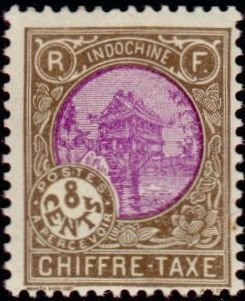Stamp: Mot-Cot pagoda (French Indochina 1927)
Mot-Cot pagoda (French Indochina 1927)
26 September (French Indochina ) within release Indigenous motifs goes into circulation Stamp Mot-Cot pagoda face value 8 French Indochinese cent
| Stamp Mot-Cot pagoda in catalogues | |
|---|---|
| Yvert et Tellier: | Yt:FR-ICT51 |
| Michel: | Mi:FR ICP 51 |
Stamp is square format.
Stamp TaxAlso in the issue Indigenous motifs:
- Stamp - Foundation of Saigon face value 2;
- Stamp - Plowman and tower of Confucius face value 1/10;
- Stamp - Plowman and tower of Confucius face value 1/5;
- Stamp - Plowman and tower of Confucius face value 2/5;
- Stamp - Plowman and tower of Confucius face value 4/5;
- Stamp - Plowman and tower of Confucius face value 1;
- Stamp - Plowman and tower of Confucius face value 2;
- Stamp - Plowman and tower of Confucius face value 3;
- Stamp - Plowman and tower of Confucius face value 4;
- Stamp - Plowman and tower of Confucius face value 5;
- Stamp - Halong Bay face value 6;
- Stamp - Halong Bay face value 7;
- Stamp - Halong Bay face value 8;
- Stamp - Halong Bay face value 9;
- Stamp - Halong Bay face value 10;
- Stamp - Halong Bay face value 11;
- Stamp - Halong Bay face value 12;
- Stamp - Angkor Vat face value 15;
- Stamp - Angkor Vat face value 20;
- Stamp - Woodcarver face value 25;
- Stamp - Woodcarver face value 30;
- Stamp - That Luong face value 40;
- Stamp - That Luong face value 50;
- Stamp - Foundation of Saigon face value 1;
- Stamp - Mot-Cot pagoda face value 2/5;
- Stamp - Mot-Cot pagoda face value 4/5;
- Stamp - Mot-Cot pagoda face value 1;
- Stamp - Mot-Cot pagoda face value 2;
- Stamp - Mot-Cot pagoda face value 3;
- Stamp - Mot-Cot pagoda face value 4;
- Stamp - Mot-Cot pagoda face value 6;
- Stamp - Mot-Cot pagoda face value 8;
- Stamp - Dương Dragon face value 10;
- Stamp - Dương Dragon face value 12;
- Stamp - Dương Dragon face value 20;
- Stamp - Dương Dragon face value 40;
- Stamp - Dương Dragon face value 1;
Stamp Mot-Cot pagoda it reflects the thematic directions:
A building or edifice is a structure with a roof and walls standing more or less permanently in one place, such as a house or factory. Buildings come in a variety of sizes, shapes and functions, and have been adapted throughout history for a wide number of factors, from building materials available, to weather conditions, to land prices, ground conditions, specific uses and aesthetic reasons. Buildings serve several needs of society – primarily as shelter from weather, security, living space, privacy, to store belongings, and to comfortably live and work. A building as a shelter represents a physical division of the human habitat (a place of comfort and safety) and the outside (a place that at times may be harsh and harmful).
A pagoda is a tiered tower with multiple eaves common to Thailand, Cambodia, Nepal, China, Japan, Korea, Myanmar, Vietnam, and other parts of Asia. Most pagodas were built to have a religious function, most often Buddhist, but sometimes Taoist, and were often located in or near viharas. The pagoda traces its origins to the stupa, while its design was developed in ancient India. Chinese pagodas (Chinese: 塔; pinyin: Tǎ) are a traditional part of Chinese architecture. In addition to religious use, since ancient times Chinese pagodas have been praised for the spectacular views they offer, and many classical poems attest to the joy of scaling pagodas.


